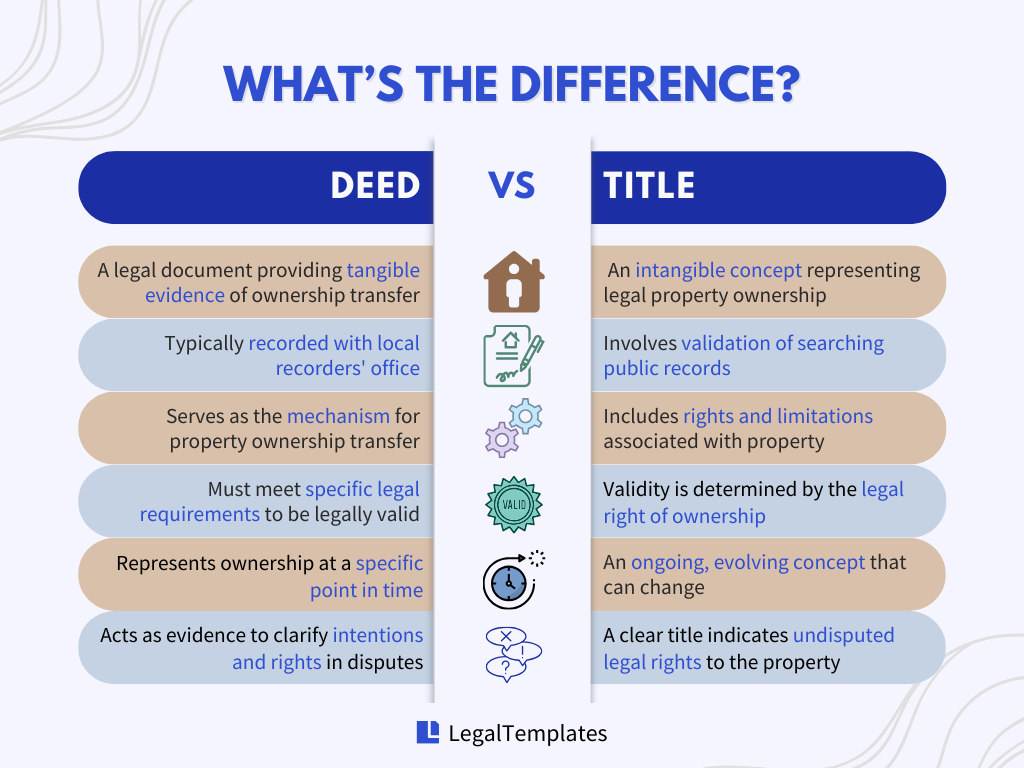
When buying or selling a property, you may come across the terms “deed” and “title.” While both are related to property ownership, they have distinct differences. Understanding these differences is essential for a smooth real estate transaction.
In short, a deed is a physical document that evidences the transfer of property ownership, while a title refers to the legal conceptual right to own and use the property.
To illustrate this concept with a simple analogy, consider the act of purchasing a book in a bookstore. In this scenario, the receipt you receive upon purchase serves as the deed — a tangible record that proves you have transferred payment to the bookstore in exchange for the book, similar to how a property deed evidences the transfer of real estate ownership.
Meanwhile, your ownership of the book itself represents the title. It is the legal conceptual right that allows you to possess, enjoy, and use the book as you see fit, similar to how property title confers the rights of ownership, use, and enjoyment of real estate.
In this article, we will explore the key differences between deeds and titles and how they function in the ownership transfer process.
6 Key Differences Between Deeds and Titles

Nature of Existence
As previously mentioned, a deed is a physical, legal document that provides tangible evidence of the transfer of ownership. It is signed by both the seller (grantor) and the buyer (grantee) to signify the transfer of property.
On the other hand, a title is not a physical document but a legal, intangible concept that represents the legal ownership of a property. It encompasses the bundle of rights associated with the property.
Validation Process
Deeds are typically recorded with the appropriate local recorders’ office (in the county where the property is located) after execution and delivery. This recording process ensures that the deed becomes a part of the public record, providing a clear chain of ownership history for the property. Recording deeds also makes the details of the property transfer accessible to the public.
On the contrary, titles involve a validation process that includes searching public records to verify the ownership history of the property. Title insurance companies conduct thorough research to establish a legitimate chain of title, clear any outstanding liens or claims, and ensure the buyer receives a marketable title.
While title histories are reflected in public records, they do not require any specific document to be publicized beyond those records; the title exists as a collection of rights associated with the property.
Function and Content
A deed’s primary function is to serve as the mechanism for transferring ownership from the seller to the buyer. It contains essential details such as:
- The names of the parties involved;
- A legal description of the property;
- The consideration (usually the purchase price), and
- Any terms and conditions of the transfer.
On the other hand, a title includes the actual rights and limitations associated with the property, such as mineral rights, air rights, easements, or any restrictions on use. More specifically, the general bundle of rights include:
- The Right of Control: Your ability to use the property legally.
- The Right of Disposition: Your right to permanently or temporarily transfer ownership of the property as long there are no loans, liens, or other encumbrances. These factors do not necessarily prevent transfer but may complicate it – a property can still be sold with a mortgage, but the mortgage usually needs to be paid off with the sale proceeds.
- The Right of Enjoyment: Your right to enjoy the property legally. (This is distinct from the right of control.)
- The Right of Exclusion: Your right to choose who is allowed on the property.
- The Right of Possession: Your legal right to claim property ownership.
IMPORTANT
While a deed establishes title transfer, holding a deed itself does not constitute ownership without a clear title. Therefore, many home buyers chose to purchase title insurance to protect against potential claims or problems related to the property’s ownership.
Temporal Aspect
A deed represents ownership at a specific point in time. Once the deed is executed and delivered, it signifies the transfer of ownership from the seller to the buyer. The deed becomes effective upon delivery and acceptance.
In contrast, a title is an ongoing, evolving concept that can change as the property is bought, sold, or otherwise transferred. It reflects the current ownership status of the property and may be subject to future changes based on subsequent transactions.
Legal Requirements
A deed must meet specific legal requirements to be considered valid, such as being in writing, having a clear description of the property, and being signed by the party transferring the property (grantor).
A title’s validity is determined by the legal right of ownership and the absence of claims or liens against the property.
Role in Disputes
In legal disputes, the deed is examined as a primary piece of evidence. The deed can be used to establish what was intended by the parties involved during the transfer, the nature of the property rights that were supposed to be conveyed, and any conditions or limitations attached to the transfer.
For instance, if there’s a dispute over whether the property was meant to include certain rights (like mineral rights), the deed would be the first document reviewed for clarification.
The type of deed used in the property transfer can significantly affect the outcome of disputes. Some common deed types include:
- Quitclaim Deed: A quitclaim deed offers the least protection for the buyer, transferring only the seller’s current interest in the property without any warranties regarding the title’s quality;
- General Warranty Deed: A general warranty deed provides comprehensive protection, guaranteeing the buyer against any title issues from the property’s history;
- Special Warranty Deed: Special warranty deeds offer a middle ground, with the seller only guaranteeing against title defects that occurred during their ownership period. They are commonly used in commercial property transfers.
► READ MORE: 9 Types of Deeds Used to Transfer Ownership
The title’s status is crucial in resolving disputes related to the legality of ownership. A clear title indicates that the property owner has undisputed legal rights to the property, free from liens, judgments, or other encumbrances.
Incorporating an affidavit of title into the sale process can further facilitate the transaction by providing a sworn statement from the seller affirming the clear status of the title. This affidavit confirms there are no outstanding issues such as unpaid taxes, liens, or other encumbrances that haven’t been disclosed previously.
If the title search reveals issues (such as a previous owner’s unpaid taxes leading to a lien on the property), these must be resolved for the current owner to have a clear title. In disputes, the focus is often on whether the title was clear at the time of transfer and whether any defects were known or should have been disclosed.
Dispute resolution might involve court proceedings to clear title issues, validate the deed’s execution, or enforce the terms of the deed. Alternatively, title insurance plays a crucial role in protecting buyers from losses due to defects in the title that were not known at the time of purchase, providing a financial and legal buffer in resolving these disputes.
Now that we have explored the key differences between deeds and titles, let’s delve into how they work in the ownership transfer process.
How Deeds and Titles Work in Property Ownership Transfer

The property ownership transfer process involves several steps, and both deeds and titles play crucial roles in ensuring a smooth transaction. Here is a brief overview of how deeds and titles work in the ownership transfer process:
- Purchase Agreement: The buyer and seller enter into a purchase agreement, outlining the terms and conditions of the sale.
- Title Search: A title company conducts a title search to examine the property’s ownership history and uncover any potential issues or claims on the title. This step ensures that the seller has a marketable title and can legally transfer ownership.
- Preparation of Deed: A deed is prepared once the title search is complete and the sale proceeds. The deed includes the necessary details of the transfer, such as the parties’ names, property description, and purchase price.
- Closing: During the closing, both the seller and the buyer sign the deed. The buyer provides the funds for the purchase, and the seller delivers the deed to the buyer.
- Recording the Deed: After the closing, the deed is recorded with the appropriate land records office. This step ensures that the transfer of ownership becomes a matter of public record.
- Title Insurance: The buyer may obtain title insurance to protect against any unforeseen issues or claims on the property’s title. Title insurance provides assurance and financial coverage in case of any title defects or disputes.
By following these steps and ensuring the proper execution and recording of the deed, along with a thorough title search and title insurance, the property ownership transfer process can be completed successfully.
Conclusion
While a deed is a physical document that provides evidence of the transfer of ownership, a title represents the legal concept of ownership and includes associated rights and limitations.
Deeds and titles work together to ensure a smooth ownership transfer process, with the deed serving as the mechanism for transferring ownership and the title validating the ownership rights.
By comprehending these distinctions and following the appropriate steps in the ownership transfer process, buyers and sellers can navigate real estate transactions with confidence.
